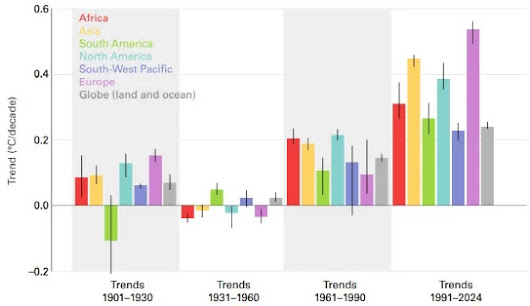Asia warming nearly twice as fast as the global average is the alarming conclusion from the latest “State of the Climate in Asia 2024” report released by the World Meteorological Organisation (WMO). This finding underscores the growing climate emergency in Asia, with dangerous implications for its people, economies, and ecosystems.
Asia Warming Trend Reaches Record High in 2024
The WMO report confirms that Asia warming nearly twice as fast as global trends has led to widespread and prolonged heatwaves in 2024, marking the year as either the warmest or second warmest on record. This warming pattern, observed between 1991 and 2024, is nearly double that of the 1961–1990 period, showing the acceleration of climate change in the region.
Marine Heatwaves Show Extent of Warming
A striking revelation is that Asia warming nearly twice as fast has also resulted in record-high sea surface temperatures. Massive marine heatwaves gripped much of Asia’s ocean surface, with a decadal sea surface warming rate of 0.24°C—again, almost double the global average of 0.13°C.
Rising Sea Levels Threaten Coastal Regions
In tandem, sea level rise in the Indian and Pacific Oceans bordering Asia has outpaced the global mean, further threatening low-lying coastal communities. This phenomenon is directly linked to Asia warming nearly twice as fast and is exacerbating regional vulnerabilities.
Himalayan Glaciers Face Accelerated Melting
Another critical impact of Asia warming nearly twice as fast is the rapid retreat of glaciers in High-Mountain Asia. The region, which includes parts of the Himalayas and Tian Shan ranges, is home to the largest volume of ice outside the polar regions. Of the 24 glaciers monitored in 2023–2024, 23 experienced mass loss. Urumqi Glacier No. 1 in the Tian Shan range recorded its worst mass balance since 1959, proving the devastating effects of Asia warming nearly twice as fast.

Climate Disasters Escalating Across Asia
The report elaborates on how Asia warming nearly twice as fast contributes to intensified climate disasters, including deadly rainfall events, floods, and tropical cyclones. Prolonged droughts have also triggered major agricultural and economic disruptions. These crises have deepened the humanitarian toll of climate change, with Asia warming nearly twice as fast playing a central role.
Urgent Warning from WMO Leadership
WMO Secretary-General Celeste Saulo emphasized that Asia warming nearly twice as fast is already exacting an unacceptably high toll. She stated, “The State of the Climate in Asia report highlights the changes in key climate indicators such as surface temperature, glacier mass, and sea level. Extreme weather is already exacting an unacceptably high toll.”
Nepal Case Study Shows Hope in Early Warnings
The WMO report further demonstrates that Asia warming nearly twice as fast affects all corners of the continent. A case study from Nepal shows that improved early warning systems have helped reduce disaster impacts. According to the WMO, anticipatory actions like these are essential for protecting lives and livelihoods in regions highly exposed to climate risks—especially where Asia warming nearly twice as fast intensifies those risks.
Marine Heatwaves Reach Unprecedented Scale
Marine heatwaves, linked to Asia warming nearly twice as fast, covered nearly 15 million square kilometers of ocean in 2024—equivalent to one-tenth of Earth’s ocean surface. Areas like the northern Indian Ocean, waters around Japan, the Yellow Sea, and the East China Sea saw heatwaves of strong to extreme intensity—the worst since satellite records began in 1993.
Arctic Ice Melt and Glacial Loss Continue
Asia warming nearly twice as fast also continues to impact Arctic sea ice. Massive ice melt and the northward shift of the ice edge were recorded across the region, adding another layer of concern to the WMO’s findings.
Water Security Threatened by Glacier Loss
WMO warns that Asia warming nearly twice as fast threatens water security for billions. The High-Mountain Asia region’s ice reserves feed major river systems like the Ganges, Brahmaputra, and Yangtze. Their depletion means long-term consequences for agriculture, drinking water, and energy security for countries downstream.
Time for Urgent Action
Asia warming nearly twice as fast is not just a regional crisis—it is a global signal of accelerating climate breakdown. The WMO’s urgent call to enhance early warning systems and build climate resilience across Asia must be heeded. The evidence is clear: Asia warming nearly twice as fast as the global average demands bold action now.
Delhi Weather Update: 45°C Heatwave to Continue Till June 12


